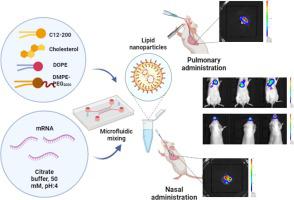当前位置:
X-MOL 学术
›
Eur. J. Pharm. Biopharm.
›
论文详情
Our official English website, www.x-mol.net, welcomes your feedback! (Note: you will need to create a separate account there.)
Lipid nanoparticles for local delivery of mRNA to the respiratory tract: Effect of PEG-lipid content and administration route
European Journal of Pharmaceutics and Biopharmaceutics ( IF 4.9 ) Pub Date : 2024-03-16 , DOI: 10.1016/j.ejpb.2024.114266 Melike Ongun , Abhijeet Girish Lokras , Saahil Baghel , Zhenning Shi , Signe Tandrup Schmidt , Henrik Franzyk , Thomas Rades , Federica Sebastiani , Aneesh Thakur , Camilla Foged
European Journal of Pharmaceutics and Biopharmaceutics ( IF 4.9 ) Pub Date : 2024-03-16 , DOI: 10.1016/j.ejpb.2024.114266 Melike Ongun , Abhijeet Girish Lokras , Saahil Baghel , Zhenning Shi , Signe Tandrup Schmidt , Henrik Franzyk , Thomas Rades , Federica Sebastiani , Aneesh Thakur , Camilla Foged

|
Design of inhalable mRNA therapeutics is promising because local administration in the respiratory tract is minimally invasive and induces a local response. However, several challenges related to administration via inhalation and respiratory tract barriers have so far prevented the progress of inhaled mRNA therapeutics. Here, we investigated factors of importance for lipid nanoparticle (LNP)-mediated delivery of mRNA to the respiratory tract. We hypothesized that: (i) the PEG-lipid content is important for providing colloidal stability during aerosolization and for mucosal delivery, (ii) the PEG-lipid contentinfluences the expression of mRNA-encoded protein in the lungs, and (iii) the route of administration (nasal versus pulmonary) affects mRNA delivery in the lungs. In this study, we aimed to optimize the PEG-lipid content for mucosal delivery and to investigatethe effect of administration route on the kinetics of protein expression. Our results show that increasing the PEG-lipid content improves the colloidal stability during the aerosolization process, but has a negative impact on the transfection efficiency. The kinetics of protein expressionis dependent on the route of administration, and we found that pulmonaryadministration of mRNA-LNPs to mice results inmore durable protein expression than nasaladministration. These results demonstrate that the design of the delivery system and the route of administration are importantfor achieving high mRNA transfection efficiency in the respiratory tract.
中文翻译:

用于将 mRNA 局部递送至呼吸道的脂质纳米颗粒:PEG-脂质含量和给药途径的影响
可吸入 mRNA 疗法的设计是有前景的,因为呼吸道局部给药是微创的,并且会引起局部反应。然而,迄今为止,与通过吸入和呼吸道屏障给药相关的一些挑战阻碍了吸入 mRNA 疗法的进展。在这里,我们研究了脂质纳米颗粒 (LNP) 介导的 mRNA 递送至呼吸道的重要因素。我们假设:(i)PEG-脂质含量对于在雾化过程中提供胶体稳定性和粘膜递送非常重要,(ii)PEG-脂质含量影响肺部中mRNA编码蛋白的表达,以及(iii)途径给药方式(鼻腔与肺部)会影响肺部的 mRNA 递送。在本研究中,我们旨在优化粘膜递送的 PEG-脂质含量,并研究给药途径对蛋白质表达动力学的影响。我们的结果表明,增加 PEG-脂质含量可以提高雾化过程中的胶体稳定性,但会对转染效率产生负面影响。蛋白质表达的动力学取决于给药途径,我们发现对小鼠进行肺部给药 mRNA-LNP 会比鼻腔给药产生更持久的蛋白质表达。这些结果表明,递送系统的设计和给药途径对于在呼吸道中实现高 mRNA 转染效率非常重要。
更新日期:2024-03-16
中文翻译:

用于将 mRNA 局部递送至呼吸道的脂质纳米颗粒:PEG-脂质含量和给药途径的影响
可吸入 mRNA 疗法的设计是有前景的,因为呼吸道局部给药是微创的,并且会引起局部反应。然而,迄今为止,与通过吸入和呼吸道屏障给药相关的一些挑战阻碍了吸入 mRNA 疗法的进展。在这里,我们研究了脂质纳米颗粒 (LNP) 介导的 mRNA 递送至呼吸道的重要因素。我们假设:(i)PEG-脂质含量对于在雾化过程中提供胶体稳定性和粘膜递送非常重要,(ii)PEG-脂质含量影响肺部中mRNA编码蛋白的表达,以及(iii)途径给药方式(鼻腔与肺部)会影响肺部的 mRNA 递送。在本研究中,我们旨在优化粘膜递送的 PEG-脂质含量,并研究给药途径对蛋白质表达动力学的影响。我们的结果表明,增加 PEG-脂质含量可以提高雾化过程中的胶体稳定性,但会对转染效率产生负面影响。蛋白质表达的动力学取决于给药途径,我们发现对小鼠进行肺部给药 mRNA-LNP 会比鼻腔给药产生更持久的蛋白质表达。这些结果表明,递送系统的设计和给药途径对于在呼吸道中实现高 mRNA 转染效率非常重要。



























 京公网安备 11010802027423号
京公网安备 11010802027423号